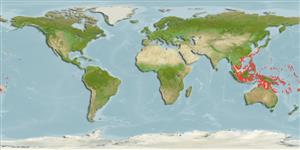Common names from other countries
>
Eupercaria/misc (Various families in series Eupercaria) >
Lutjanidae (Snappers) > Lutjaninae
Etymology: Lutjanus: Malay, ikan lutjan, name of a fish.
More on author: Lacepède.
Environment: milieu / climate zone / depth range / distribution range
Ecologia
marino associati a barriera corallina; distribuzione batimetrica 3 - 50 m (Ref. 9710). Tropical; 35°N - 21°S, 93°E - 170°W
Western Pacific: Sumatra to Samoa, north to southern Japan. Apparently restricted to the western Pacific (Ref. 30829).
Size / Peso / Age
Maturity: Lm ? range ? - ? cm
Max length : 35.0 cm TL maschio/sesso non determinato; (Ref. 48635); common length : 20.0 cm TL maschio/sesso non determinato; (Ref. 55)
Spine dorsali (totale): 10 - 11; Raggi dorsali molli (totale): 13-14; Spine anali 3; Raggi anali molli: 8. Snout somewhat pointed. Eye large. Preorbital bone narrow, its width much less than eye diameter. Preopercular notch and knob well developed. Scale rows on back rising obliquely above lateral line. Generally pink or reddish, white or silvery below. Usually a series of ten to twelve stripes is on the side. Some specimens have black spot on the back below the anterior part of the soft dorsal fin.
Adults inhabit coral reefs. Often seen in schools near outcrops or drop-offs, often with other species (Ref. 9710), of up to about 30 to 40 individuals. Small juveniles on shallow algae reef, often near freshwater run-offs (Ref. 48635). Feed on fishes, shrimps, crabs, other crustaceans, cephalopods and some planktonic items.
Life cycle and mating behavior
Maturità | Riproduzione | Deposizione | Uova | Fecundity | Larve
Allen, G.R., 1985. FAO Species Catalogue. Vol. 6. Snappers of the world. An annotated and illustrated catalogue of lutjanid species known to date. FAO Fish. Synop. 125(6):208 p. Rome: FAO. (Ref. 55)
IUCN Red List Status (Ref. 130435)
CITES (Ref. 128078)
Not Evaluated
Threat to humans
Harmless
Human uses
Pesca: scarso interesse commerciale
Informazioni ulteriori
BibliografiaAcquacolturaProfilo di acquacolturaVarietàGeneticaElectrophoresesEreditarietàMalattieElaborazioneMass conversion
CollaboratoriImmaginiStamps, Coins Misc.SuoniCiguateraVelocitàModalità di nuotoArea branchialeOtolithsCervelliVista
Strumenti
Special reports
Download XML
Fonti Internet
Estimates based on models
Preferred temperature (Ref.
115969): 24.3 - 29, mean 28.2 (based on 542 cells).
Phylogenetic diversity index (Ref.
82804): PD
50 = 0.5000 [Uniqueness, from 0.5 = low to 2.0 = high].
Bayesian length-weight: a=0.01479 (0.00706 - 0.03101), b=2.97 (2.81 - 3.13), in cm Total Length, based on LWR estimates for this Genus-body shape (Ref.
93245).
Trophic level (Ref.
69278): 3.8 ±0.56 se; based on food items.
Resilienza (Ref.
120179): Alto, tempo minimo di raddoppiamento della popolazione meno di 15 mesi (Preliminary K or Fecundity.).
Fishing Vulnerability (Ref.
59153): Low vulnerability (25 of 100).
